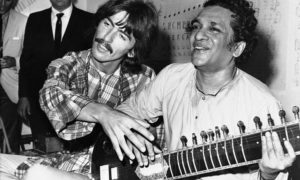A Brief History of the Sitar and its Popularity in Rock Music
 Classical Indian Music
Classical Indian Music
It’s interesting to know that all countries with deep histories have their own style of classical music. If you take a look at countries in Europe, their music traditions go back a long time and usually we think of composers like Bach, Chopin and Mozart. In other parts of the world, while countries may have similarly deep or even deeper musical traditions, their composers may not be so famous — or rather their “classical music” is less a matter of compositions and composers and more just a style played with specific instruments.
I think it’s a great privilege for a country to be aware of their musical history. Sadly, the way history has panned out, while some civilizations are able to keep their music traditions alive and popular, others struggle to keep even knowledge of it.
In the case of classical Indian music, it has never really slowed down. Even though it can be traced back to B.C. times, if you walk around India today, you’ll be bound to hear classical Indian music playing. The instruments that they’ve been using for hundreds of years are still widely used today, be it on radio music, jingles on TV or in films. Some instruments, like the sitar, have even made their impact across the world.
The Sitar
The sitar is one of the most famous instruments from India and an important piece of classical Indian music. It is an ancient stringed instrument that you pluck like a lute. Although its history is often disputed, it is generally accepted that the sitar was invented sometime in medieval India either by Sufis of the west or Indians themselves. It didn’t really become popular until the 16th and 17th century but it didn’t turn into the instrument that we know of today until the 18th century.
The sitar looks similar to a lute except it has a smaller body and longer neck. They typically have between 18 to 21 strings, 4 to 7 of which are strung over curved metal frets and played, the remaining strings are sympathetic strings which resonate when the others are plucks, giving the sitar the distinct vibrating sound that it is known for.
Ravi Shankar
Arguably the man who popularized the sitar outside of India is Ravi Shankar. Born in 1920, as a child Ravi and his older brother performed traditional Indian dances across. Together they toured Europe and educated people on Indian culture. It wasn’t until Ravi turned 18 years old that he
decided to quit his dancing career to study the sitar. After many years he mastered the instrument and started being invited to different countries around the world to play it, particularly Germany and the United States.
Once there, he popularized the sitar instrument by intriguing those who listened to him play. In 1956 he released the album 3 Ragas and after that Ravi Shankar was the man every band and musician wanted to meet and collaborate with.
In Popular Music
After recording and touring in the United States, many prominent musicians became a fan of Ravi Shankar, including David Crosby of The Byrds. While the sitar’s popularity was slowly building, it was after Ravi Shankar met George Harrison of The Beatles that really put the instrument on the map.
According to George Harrison’s wife, Olivia Harrison:
“When George heard Indian music, that really was the trigger, it was like a bell that went off in his head. It not only awakened a desire to hear more music, but also to understand what was going on in Indian philosophy. It was a unique diversion.”
Soon after meeting Ravi Shankar, George Harrison went to India and purchased a sitar for himself. Not only that, but he also took lessons from Ravi and was generally interested in Indian culture.
Upon returning to England, The Beatles recorded the song “Norwegian Wood (The Bird Has Flown)” featuring a sitar and from that moment on many other bands started using the mystical-sounding Indian instrument on their tracks.
This was in the 60s and 70s when young people started to reject tradition. It was a time to experiment and play with different ideas, including music, and it was no mistake that the sitar was excellent at providing a unique, droning sound that strayed away from the conventional instruments of rock and roll. This phenomena of fusing the sitar with rock music came to be known as raga rock.
It is important to mention that the mysticism behind Indian culture also contributed to the popularity of the sitar, especially because at the time many young people were experimenting with drugs in order to find deeper meaning in their lives. The sitar and psychedelic culture went hand-in-hand (according to hippies).
Other songs that featured the sitar are:
“Paint it Black” the The Rolling Stones
“Black Mountain Side” by Led Zeppelin
“Venus in Furs” by The Velvet Underground
“Within You Without You” by The Beatles
“The End” & “Indian Summer” by The Doors
Conclusion
No doubt the sitar had an impact on popular music at the time. On one hand it’s great that unconventional instruments were at one point fused with rock music, but on the other hand there seems to be a sense of exploitation of one of India’s most traditional and sometimes spiritual instruments. It’s possible that some bands caught on to the trend of using the sitar in their music to appear more “spiritual” to a crowd of people gobbling that sort of thing up.
Ravi Shankar upon hearing “Norwegian Wood” said:
“I couldn’t believe it, it sounded so strange. Just imagine some Indian villager trying to play the violin when you know what it should sound like.”
Ravi’s comment aside, George Harrison was genuinely touched by Indian spirituality and music and later on he admitted that that sitar on “Norwegian Wood” was “very rudimentary.”
